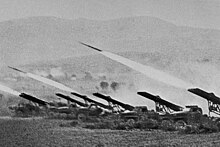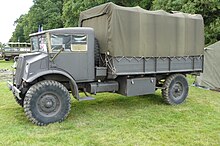Fordson WOT
The Fordson WOT or Ford WOT was a military truck that Ford of Britain produced at its factory in Dagenham near London during World War II . A total of around 130,000 copies were produced from 1939 to 1945, almost half of which were WOT 2. The abbreviation WOT stands for War Office Truck .
Model history
Fordson was originally a separate Ford company that manufactured tractors . Fordson stood for Henry Ford & Son. The Ford Motor Company had shareholders outside of the family, but all of Fordson's shares were owned by the Ford family. Starting with differentiated commercial vehicles or vehicles developed independently by Ford of Britain, Fordson was also used as the name for Ford's British commercial vehicles. Before the start of the Second World War, Ford of Britain built the Fordson Thames 7V or the Fordson E83W . The civilian truck versions of the Fordson E88 , based on the Ford barrel-nose truck , were replaced in 1939 by the Fordson Thames 7V, which had been produced in parallel for some time. The Ford or Fordson WOT was specially developed for use as a military vehicle; after the full start of series production in Dagenham, around 130 units were built every day from mid-June 1940.
Technical specifications
Generally, there were unarmored vehicles and five models numbered 1, 2, 3, 6 and 8. Models 1 to 3 were only rear-wheel drive, while the WOT 6 and 8 had all-wheel drive . The latter two models also differed in their forward control cab, while the others had a hooded vehicle cab. All vehicles were equipped with the same water-cooled Ford side valve V-8 petrol engine with 3621 cc and 85 hp at 3800 rpm. Power was transmitted through a four-speed manual transmission. The all-wheel drive models had an additional reduction gear .
WOT 1
The WOT 1 was introduced in 1940, but was still based on the Fordson E88 or the Ford barrel-nose truck . He was the only one with double rear tires. The short version had a wheelbase of 4.2 meters and the long version, also known as WOT 1A WOT 1A / 1, 4.5 meters. Most of the models were delivered to the Royal Air Force , only 120 were used in the British Army. The most common version was a tank truck . Many vehicles were also equipped with special stands for the transport of air force personnel and drying of the parachutes, as fully equipped dental vehicles , searchlight vehicles and also as fire engines . fitted. It had a payload of 3 tons and reached a maximum speed of 72 km / h. 9,151 short and long wheelbase vehicles were built between 1940 and 1945.
- Length: 7.09 m
- Height: 3.10 m
- Width: 2.13 m
- Empty weight: 3.5 tons
WOT 2
In 1939 the production of the WOT 2 began, which was the smallest version of the six models with a payload of around 750 kilograms (15cwt). It was built as a flatbed truck or a box truck . In the six-year construction period there were constant improvements and the model designation ranged from A to H. The A-model had an open cabin with a tarpaulin top structure and small windows that were not completely sealed off. The E version, on the other hand, had partially closed doors made of metal but no windshield. The electrical system originally had 6 volts but was increased to 12 volts in later versions. A total of about 60,000 copies were built and used until the 1950s
- Length: 4.50 m
- Height: 2.30 m
- Width: 2.00 m
- Empty weight: 2050 kg
- Tank capacity: 104 liters
WOT 3
The WOT was mainly used by the Royal Air Force. He had a payload of approx. 1360 kg (English 30cwt). Almost 18,000 units were built between 1939 and 1944. In addition to the usual truck version, there were also special military bodies and a tractor unit with a short wheelbase.
- Length: 5.80 m
- Height: 2.60 m
- Width: 2.20 m
- Empty weight: 2950 kg
WOT 8
The only truck made in England at that time with a payload of 30 quintals (1.5 tons) and all-wheel drive was the WOT 8. In 1941 and 1942 around 2500 copies were made. The British Army also used it as an artillery tractor in North Africa . During the war, 868 units were also delivered to the Soviet Union under the Atlantic Charter , but only 731 of them made it to their destination. The Red Army used the WOT 8 as a launch pad for the Katyusha missiles .

- Length: 5.10 m
- Height 2.70 m
- Width: 2.30 m
- Empty weight: 3850 kg
- Tank capacity: 160 liters
- Range: 450 km
- Maximum speed on the road: 70 km / h
WOT 6
The WOT 6 was a WOT 8 with a longer wheelbase and a double payload of 3 tons. It also received an additional reduction gear to improve the ride quality. The WOT 6 was used closer to the front and many of the vehicles therefore had an opening on the roof in the cabin for operating machine guns, for example . Between 1942 and 1945 almost 30,000 copies were built with various special versions in addition to the standard truck. The Danish army also used the WOT 6 after the war. The last Danish WOT 6 was retired in 1974.
- Length: 6.10 m
- Height: 3.20 m
- Width: 2.30 m
- Empty weight: 5400 kg
- Tank capacity: 160 liters
- Range: 450 km
Individual evidence
- ↑ a b c d Pat Ware, p. 203.
- ↑ a b c d e website Danish military vehicles WOT2 , accessed on January 12, 2013.
- ↑ a b Bart Vanderveen, p. 160
- ↑ Bart Vanderveen, p. 163.
- ^ Machines of the Red Army in World War II, Foreign Trucks , accessed on January 12, 2013.
- ↑ a b c d e website Danish military vehicles WOT6 , accessed on January 12, 2013.
literature
- Bart Vanderveen , Historic Military Vehicles Directory, 1989, ISBN 0900913576 .
- Pat Ware , The Illustrated guide to Military Vehicles, uitgever: HermesHouse, London.



